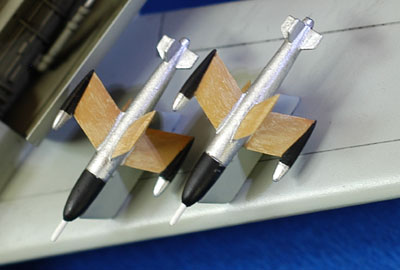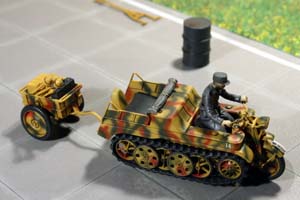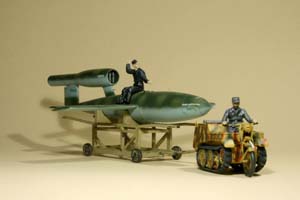

Focke-Wulf Ta-183
The Ta 183 is one of the Luft '46 paper projects, and doubtlessly one of the most significant.It is claimed, that the swept-wing jet is the ancestor of the fabulous US F-86 Sabre and the
Russian MiG 15. The ground-breaking design, created by Hans Multhopp, made it into the stage
of a wind canal model by the end of WWII. From the ruins of German airforce industry, key
personnel was transferred to the USA and to Russia - or escaped to Argentina, where the
IAe 33 Pulqui II was conceived.





The kit
The AMtech kit, while advertised to be "highly detailed", did not quite deliver. All I cansay is that it's well engineered in terms of the molding technology. Excellent fit, no flash,
and - plenty of compromises for the sake of easy production. The biggest pain I had, was to
round off the flats (which were actually draft angles, to pull the sprue out of the mold)
on the X-4 rockets without destroying the stabilizers. Other than that, the very deep panel
lines seem strange. The cockpit had to be further detailed, too. Masks provided for the canopy
were very good, and removed wihouth problems after several months on the model.
The overall geometry was quite accurate to the drawings available off the web. Obviously,
there's no real benchmark for accuracy since the plane was never built, so let's leave it at that.

I decided to make the plane in potential colors of JG 71, with Hartmann's tulip. Lacking any
better reference, I based the project on the cover illustration of the "Luftwaffe Secret Projects,
Fighters 1939-1945" by Walter Schick and Ingolf Meyer (Midland Publishing, Leicester, 1997).


The Ta 183 was supposed to carry up to 4 Ruhrstahl X-4 wire guided missiles in addition to the
30mm cannons. Shown above, the X-4 rockets as seen in the US-Air-Force Museum in Dayton
(upon which I "loosely" based the painting scheme) and my interpretation on the model.












Now for the obligatory... I ended up painting the plane in RLM 76, 81 and 83, using Xtra Color enamels.
I think they produced quite a nice result. Light weathering followed with white spirit thinned artist
oil black and brown, as well as some chalks. Top coat again Xtra Color, clear flat. The X-4s got Alclad
and Revell enamels, partially dry-brushed to get the wood-effect. The markings were pieced together from
the original kit as well as from the Italeri F-86 for the nose (took a lot of Micro Sol).
NSU Kettenkraftrad
The half-track bike is the smallest in a series of tractors, of which the half-track truck is probably the mostwell-known. The Kettenkraftrad has been built in about 10 000 units during WWII and shortly after. It was
powered by an 36HP Opel motor. The front wheel was used for stability during high speed driving on the
street (60-70km/h). For slower driving and improved manouverability the track brakes could be used.
For off-road, the front wheel could (or even should) be completely removed. For more info click here.






Since the Kettenkraftrad appeared with Tamiya's Ta-183 before, it had the handy towing bar included.
This makes for a nice setup with the Focke-Wulf.




Fieseler Fi-103 (V1 Flying bomb)

The Fi-103, better known as V1 ("Vergeltungswaffe" or "retribution weapon") was world's first cruise missile,
used in real operation. It inspired a number of following concepts, like the Chance Vought Regulus missile.
The simple design of the Fi-103, powered by a pulse-jet engine and gyroscopic stabilization system provided
the capability to strike remote targets without endangering the remaining few Luftwaffe pilots. The missile's
low accuracy, combined with allied air-superiority towards the end of WWII, prevented any large effect of the
"buzz-bomb" on the overall progress of this campaign.


Here shown together with the Focke-Wulf Ta-183.
Towards the end of WWII the supply situation in Germany was rather chaotic. Therefore the painting was more or less
randomly selected to be RLM 76,82 and 83, or at least the Revell interpretation. The painting is not based upon any
historical sources. Considering the fact, that the Ta-183 is also finished in RLM 76 and RLM 82, I guess in future
I'll stick to Extracolor for RLM color accuracy.
Again, the Kettenkraftrad provided a fitting tractor for the V1.



Well, could you resist riding the rocket? ;-)
Here the second figure out of the Kettenkraftrad-kit was put to use.



The kit is again 1/48th scale Tamiya. Like the Kettenkraftrad, the V1 kit is perfect, no flash, no putty. Some details
have been scratch built. This was my first model after many years of pause, made using a borrowed old Aztec
airbrush. The nasty Aztec nearly got me out of the hobby again ;-) All the other models are painted using my
marvellous Iwata HP Airbrush. I think the results speak for themselves...
Why Luft45+ ? Since some equippment was already used before 45, and some after, I decided for a compromise ;-)
Disclaimer: While the Ta-183 is a fictual projection based on historical camouflage pattern used on aircraft
of that era, the use of nazi markings (swastika) in no way implies a political attitude or support for that regime.
Since the display of swastikas in Germany in prohibited, the markings were digitally "modified".
All images property of J.Kierat. No use without Author's permission.
